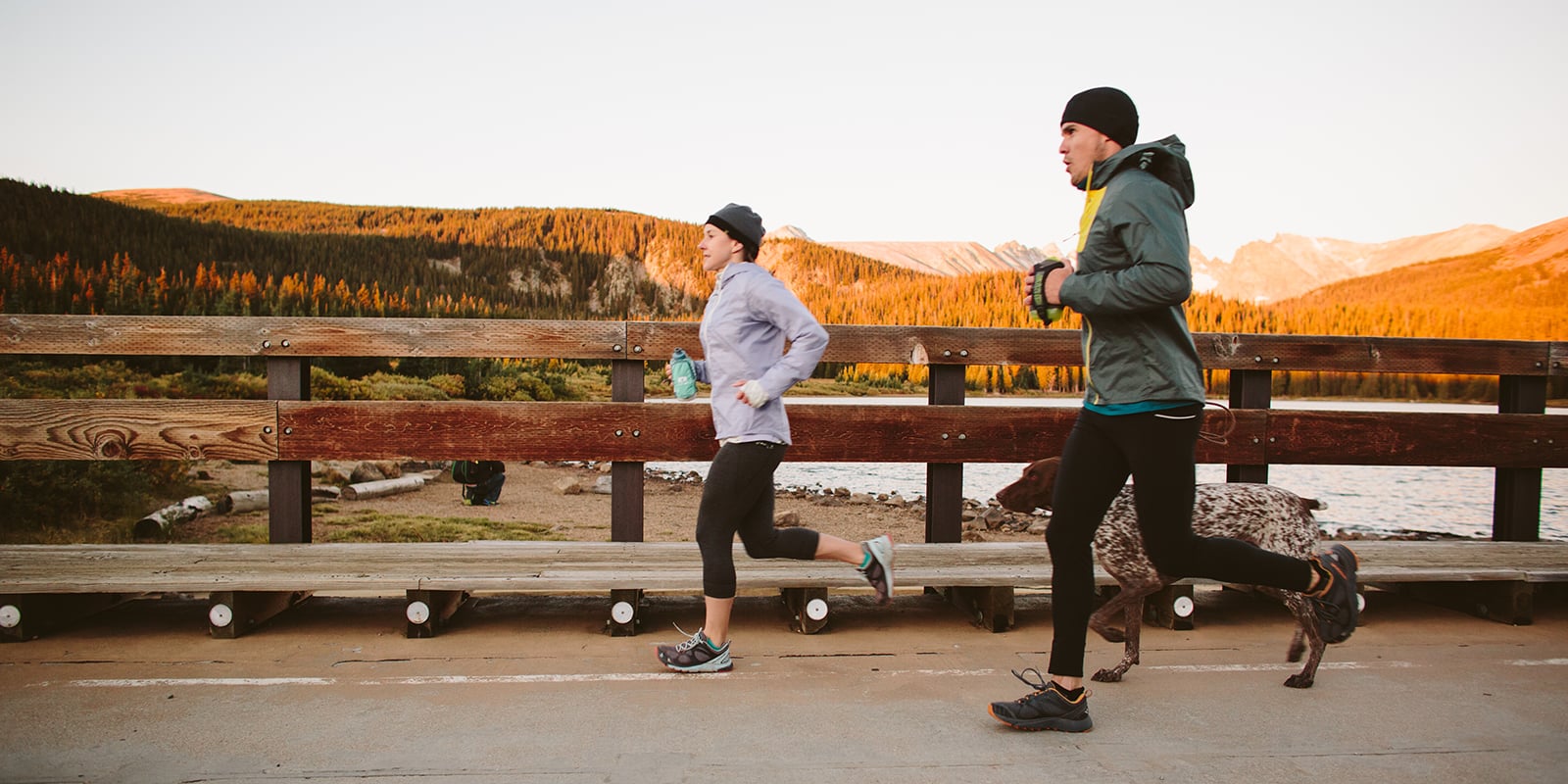Obstacle races have exploded in popularity over the past few years. For many people, an adrenaline-fueled adventure is a lot more fun than running or biking in a straight line for hours on end.
Also, when trained for and completed as a team, obstacle courses are a great outlet for building camaraderie and providing an outlet for your competitive drive.
Obstacle races require you to draw from every pillar of fitness: endurance, strength, agility, coordination and flexibility.
Enthusiasm will take you far, but the key to performing well and minimizing injury is your training and preparation. Depending on the distance and intensity of the obstacle race you choose, give yourself at least four to 12 weeks to sufficiently train and prepare.
Remember to consult with your doctor before starting any new training routine.
Set an Obstacle Course Training Schedule
When training for an obstacle course race, try to incorporate some of the "fun factor" into your training plan. Rather than doing a four-mile run, go on an "adventure run" by adding activities like burpees, walking lunges, push-ups and curb walks for balance.
It's also a good idea to take some of your training runs off of the road and treadmill and move them onto the trail to help you become accustomed to running on a more rugged landscape.
Playgrounds are a great place to do your workouts and have the added benefit of including features that are similar to those found in your upcoming race. Spend time walking on the balance beam, climbing across the monkey bars and crawling up the slide. Whenever possible, do these workouts with friends to really amp up the fun factor.
Sample Obstacle Race Training Week
| Monday | Tuesday | Wednesday | Thursday | Friday | Saturday | Sunday |
|---|---|---|---|---|---|---|
| Strength workout | Rest | 3-5 mile adventure run | Strength workout | Rest | Long run | Endurance cardio training |
Endurance Cardio Training for Obstacle Races
Obstacle race distances vary widely in length, from three to more than 26 miles, so your ability to run and perform for long durations of time should not be overlooked.
You should dedicate one day per week to a long run. If you are training for a 12-mile obstacle race, begin your long run day at three miles and build to 12 or more miles by the time of your race.
Dedicate at least one other day of the week to cardiovascular training. Doing other activites such as cycling, swimming, or rollerblading for 30-60 minutes is a great way to cross-train for obstacle racing.
Strength Workout for Obstacle Races
Obstacle races involve a wide range of movements, including pulling, jumping, carrying, pressing, balancing and crawling.
Take the time to research your race ahead of time. Many races will give you an idea of the obstacles you can expect. Select exercises that will prepare you for these specific obstacles.
Leading up to the big event, focus at least two days per week of your training on strength training.
Hop and Hold on BOSU Balance Trainer
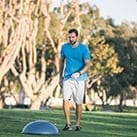
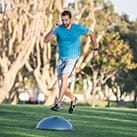
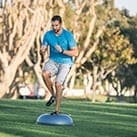
During your race, you'll face unstable situations and moments when dynamic balance is essential.
Perform 2 sets of 10 repetitions per leg on a BOSU (half-dome balance trainer).
- Stand about 2 to 3 feet behind a BOSU (dome side up) and step or leap off of your right foot and land with your left foot centered on the ball.
- Absorb the landing by bending at the knee and hip.
- Maintain balance for a few seconds before stepping off and repeating on the other leg.
Modification: This exercise can also be done as a step (instead of a hop) onto the BOSU; you can also perform the move on the floor without the BOSU.
Kettlebell Squat to Overhead Press
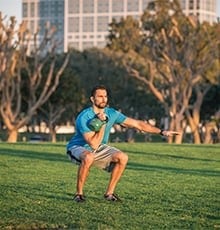

Many races involve lifting an object above your head, such as a log or even a teammate to help get them over the wall. This move helps develop overall power and pressing strength.
Do 2 sets of 12 repetitions per side; rest 30 seconds between sets.
- Begin by holding a medium-weight kettlebell in your right hand next to your chest with the palm facing inward.
- Drop your hips down and back; drive through your glutes and return to standing while thrusting the kettlebell into the air.
- Slowly return the kettlebell to your chest and repeat.
Modification: This exercise can also be performed with a dumbbell by starting with the palm facing perpendicular to the body and ending with palm facing out away from the body when the arm is extended overhead.
Pull-Ups
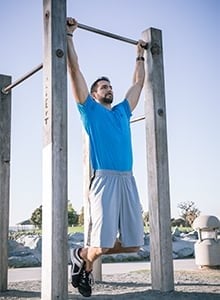

Pulling is the primary foundational movement used in obstacle races; it's used for pulling yourself up and over a wall or perhaps pulling a teammate out of a mud pit.
Do 2 sets of 12 repetitions; rest 30 to 60 seconds between sets.
- Grasp a pull-up bar with an overhand grip, hands slightly wider than shoulder-width apart.
- Pull your body up so the top of your chest reaches the bar.
- Focus on pulling your elbows down and back by engaging your upper back.
Modification: Pull-ups are very challenging for most people—try placing a step or bench under your feet from which you can "power up" your chest to the bar.
Spiderman Push-ups
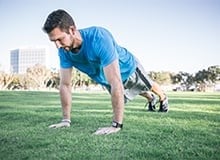

These races require you to get low. Push-ups teach you how to lower yourself in a controlled manner while performing a crawling motion.
Do 2 sets of 12 repetitions (6 per side); rest 30 to 60 seconds between sets.
- Assume a proper plank position and lower your body about 5 inches from the floor.
- As you lower, lift your left leg off the ground and bend your left knee out toward your left elbow.
- Replace your left leg and repeat on the other side.
Modification: If the push-up is too challenging, practice holding a hand plank position while bringing the left knee to the left elbow and switching.
Elevated Step-downs
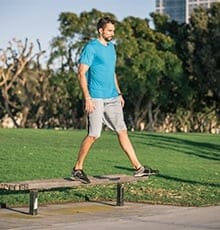

Knee and ankle injuries are quite common in obstacle races. Practice proper landings with this exercise.
Do 3 sets of 10 repetitions; rest 60 seconds between sets.
- Stand on an elevated surface at or lower than your knee height.
- Step off and land on the ground softly while absorbing the impact with your hips, knees and ankles.
Modification: If you aren't yet comfortable stepping off of an elevated object, practice jumping in place and landing softly.
Band Muscle-Up



This modified version of muscle-ups will have you pulling yourself over walls and logs with greater ease.
Do 2 sets of 12 repetitions; rest 30 to 60 seconds between sets.
- Attach a two-handled resistance band to an anchor point.
- Grasp the band with both hands and pull your elbows back into a row. Keep your knees slightly bent, and avoid arching your back by tightening your core muscles.
- Then, use the triceps to press the palms backward.
Modification: Try doing this one arm at a time.
Clock Lunges
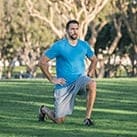

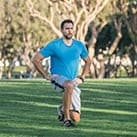
These lunges prepare you to step and bend in various directions.
Do 2 sets (a set is one time around on each leg); rest 30 to 60 seconds between sets.
- Imagine that you're standing in the center of a clock face. Keep your right foot planted and lunge forward on your left leg to 12 o'clock. Both knees are bent; your front knee should be in alignment over your front toes.
- Return to standing and lunge laterally to 11 o'clock. Continue lunging toward 10 o'clock, 9 o'clock, etc. until you reach 5 o'clock with your right leg crossed slightly behind you.
- Keep your chest in line with your hips throughout the exercise.
- Switch legs and repeat on the other side, moving clockwise.
Modification: To increase the balance challenge, do not put your foot down between lunges, rather move from one to the next keeping the foot elevated when returning to center.
Army Crawl
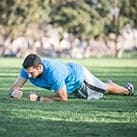
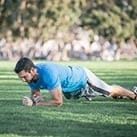
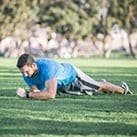
Much of your race will be spent with your forearms on the ground as you crawl through tubes, mud and under barbed wire, so your shoulders and core muscles need to be ready for the challenge.
Do 3 sets of 30 yards each; rest 30 to 60 seconds between sets.
- Begin in a forearm plank.
- Allow your feet to drag behind you as you pull yourself across the floor for about 30 yards.
Modification: To make this a bit easier, try wearing a pair of socks on a slick floor or put sliders under your feet. If you are not able to maintain a proper plank during this activity, begin with your knees on the ground.
Kettlebell Farmer Carry

From holding onto the monkey bars to pulling yourself up and over walls, grip strength is key in obstacle races.
Do 3 sets of 30 yards each; rest 30 to 60 seconds between sets.
- Grasp a kettlebell in each hand.
- Carry the weights about 30 yards and gently set them down.
Modification: For more of a grip challenge, try using a plate weight.
The nonprofit American Council on Exercise (ACE) educates, certifies, and represents more than 53,000 fitness professionals, health coaches, and other allied health professionals.
This publication is not intended to provide medical advice on personal health issues, which should be obtained directly from a physician.
